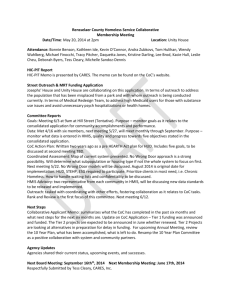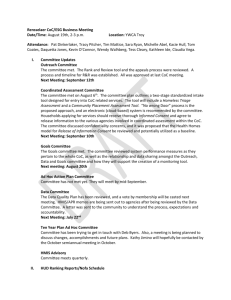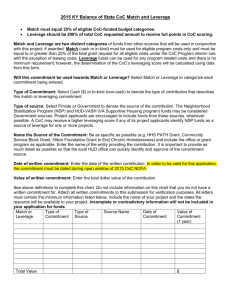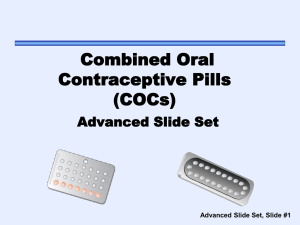Allocating the Cost of Capital
advertisement
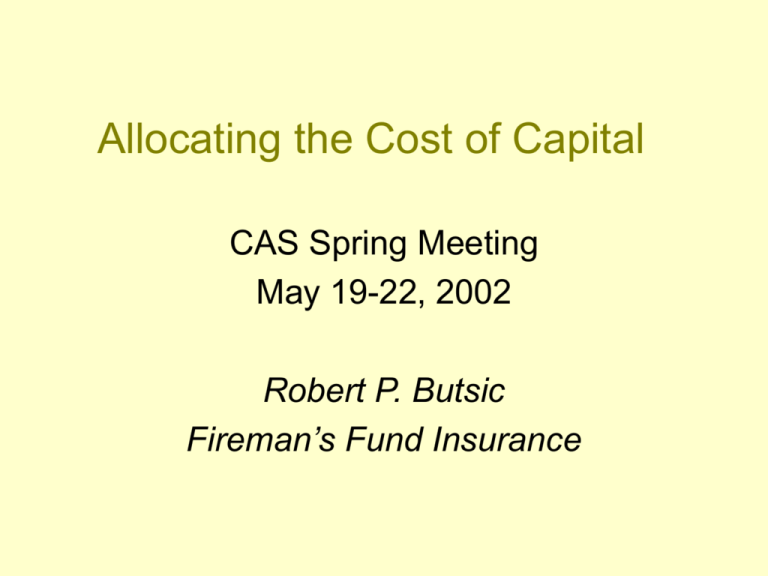
Allocating the Cost of Capital CAS Spring Meeting May 19-22, 2002 Robert P. Butsic Fireman’s Fund Insurance Why is Capital Necessary? • The answer is not obvious: – We can’t have enough capital to eliminate insurance insolvency – So why not have minimal capital and let guaranty funds protect policyholders? • Answer is: frictional insolvency costs – Additional system costs due to insolvency: – Legal fees, market disruption, extra claims handling costs 2 Optimal Capital Level Frictional Insolvency Costs Frictional Capital Costs Capital Amount 3 What is the Cost of Capital? • Investor supplies capital and expects return commensurate with risk to which the capital is exposed • This return is the cost of capital – Traditional view of insurance management – But, look from the modern finance perspective 4 Base Cost of Capital • A: Investor invests capital in a levered fund – borrow cash and invest all assets – identical to the insurer’s assets • Investor’s expected return in A is called Base Cost of Capital • B: Insurer has same balance sheet – But insurer has higher COC 5 Frictional Costs of Capital • The insurance mechanism will introduce extra costs – Government, regulation and organization – Illiquid nature of insurance liability – Information asymmetry (opaqueness) • These are frictional costs of capital – key one is double taxation – Most easily quantified 6 Double Taxation Example • Investor can directly invest in security with 10% return, but invests in ABC Insurance, who puts money in same security • ABC gets 10% return, pays 35% tax and gives 6.5% net back to investor • A losing deal unless PH can make up the difference 7 Other Frictional Costs • Regulatory costs – Capital can’t be easily moved, so investment is illiquid • Agency costs – Misalignment of owners’ and managers’ interests (Enron a classic example) • Financial distress costs – Legal fees – Distressed sale of assets 8 Financial Pricing Model • Fair premium = total present value of – loss & LAE (including risk margin) – UW expenses – Frictional capital costs • Note that traditional (base) cost of capital is embedded in risk margin 9 Risk Margin and COC Example • Assumptions – Fair premium is $1000, paid up front, $1040 loss paid in one year – Risk-free rate of 6%, $500 of capital required – No frictional COC, taxes or expenses • Calculation – Initial assets of $1500 grow to $1590, leaving $550 for a 10% return (COC) – Risk margin is $18.87 = 1000 - 1040/1.06 10 RM and COC Example, Cont. • Which comes first, the RM or the COC? – Each implies the other • In determining a fair premium, it must be the risk margin: – Products have different levels of risk – What COC should a riskless coverage have? • Thus, the COC is not fixed for an insurer -- it varies by product 11 Allocating Capital Costs • For pricing or performance measurement, must allocate capital costs to product • If we know the RM, then we need to allocate the frictional COC • If we don’t know the RM, and use a COC pricing model, then we allocate both frictional and base COC 12 Capital Allocation • In order to assess capital costs by product, we first need to allocate capital to product • There are many methods – Lots of ad hoc models – Very few economically sound models • One of them is the general Myers-Read method 13 Myers-Read Method • Uses the expected default (PH deficit) as a solvency measure – Others, such as default (ruin) probability will also work (and may be better) • Major assumptions – predetermined capital ratios exist: C ci Li – A marginal change in the line mix keeps the default measure at a constant rate: D Li d D / L 14 More on M-R Model • Other inputs – Probability distribution of loss and asset values – Means, correlations and volatilities • We solve for capital ratio ci • Result: ci c ( i 1) Z – Beta is covariance/variance – Z is distribution-dependent i iL / L2 15 Loss Beta • Relevant risk measure for capital allocation is loss beta – Volatility, correlation with portfolio and weight determine loss beta – Strong parallel with asset pricing, CAPM, portfolio optimization • Capital allocation is exact; no overlap – No order dependency 16 Numerical Example Table 1.1 Loss Beta and Capital Allocation for Numerical Example Liability Loss Loss Capital/ Value CV Beta Liability Capital Line 1 500 0.2000 0.8463 0.3957 197.87 Line 2 400 0.3000 1.3029 0.7055 282.19 Line 3 100 0.5000 0.5568 0.1993 19.93 Total 1000 0.2119 1.0000 0.5000 500.00 17 Application to Coverage Layers • For policy/treaty, capital allocation to layer depends on covariance of layer with that of unlimited loss • Layer covariance depends only on loss size distribution • Layer beta and capital/loss increase with limits 18 General Layer Beta Properties • Monotonic increasing with layer, with zero layer beta at lowest point layer • Generally unbounded 25.00 Legend: RHS top to bottom 20.00 15.00 Pareto Lognormal Exponential Gamma Normal 10.00 5.00 0.00 0 50 100 150 200 250 300 350 400 x 19 Practical Applications • Best measure of capital is economic (fair) value • As an approximation, capital is proportional to the loss/layer beta • For allocating a company’s capital, the relevant time horizon is one year – Allocation base is reserves plus next year’s AY incurred losses 20 Summary • Importance of frictional costs in theory of solvency and capital allocation • Myers-Read method is economically sound, with friendly (to user) results • We’ve still got a long road ahead before common agreement on capital allocation methodology 21 Further Reading • John Hancock, Paul Huber, Pablo Koch, 2001 The economics of insurance: How insurers create value for shareholders, Swiss Re Publishing http://www.swissre.com/ • Myers, Read, 2001, Capital Allocation for Insurance Companies, Journal of Risk and Insurance, 68:4, 545-580 • Butsic, 1999, Capital Allocation for Property Liability Insurers: A Catastrophe Reinsurance Application. Casualty Actuarial Society Forum, Fall 1999 22 http://www.casact.org/pubs/forum/99spforu Further Reading II • Butsic, Cummins, Derrig, Phillips, 2000, The Risk Premium Project, Phase I and II Report, CAS Website, http://casact.org/cotor/rppreport.pdf 23
